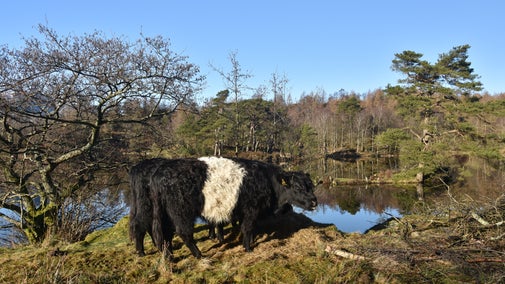
Discover more at Footprint
Find out how to get to Footprint , where to park, the things to see and do and more.

Find out how and why we created the first straw bale building in Cumbria, and the first to be built by the National Trust, at St Catherine’s Woods in the Lake District. Also learn what are the main environmental advantages of building with straw, and how the building was designed to have as small an ecological footprint as possible.
What do the following have in common: a planning officer, a bodger, a cob wall builder, a wedding dress designer, a visual artist and a National Trust Regional Director?
The answer is they all had hands-on involvement in the Footprint project at St Catherine’s Woods, near Windermere in the Lake District National Park.
Work began on the Footprint in April 2006 to create the first straw bale building in Cumbria, and the first to be built by the National Trust. Our team wanted to create a classroom, allowing school groups a space to learn and engage with us.
The building was designed to provide a welcoming space for a good-sized group of children or adults, that can be easily accessed and flexibly used by all.
We wanted the design to be sympathetic to the existing buildings (which now house National Trust offices and a staff flat) and not impose too much on the natural environment.
A straw bale building can have a lifespan of more than 100 years, but we still thought ahead to the end of the building’s natural life. We wanted it to leave a very small impact, so we chose construction materials that naturally biodegrade or can be recycled in the future.
Minimising the amount of agricultural or ecologically productive land area used.
Using building materials from local, sustainable and renewable resources, or from recycled materials, so that the impact of construction is reduced.
Create a building with excellent insulation and good use of natural light.

We also wanted the construction process and the end result to be a learning project, and excite people about achievable, low environmental impact living.
The use of straw bales in building has been widespread in Canada and the USA for over a century, and it has been increasing in the UK and in Europe over the last two decades.
The walls of the Footprint are a combination of straw and glass. Approximately 380 standard straw bales were used, sourced from a farm in Yorkshire.
The main environmental advantages of building with straw are:
• Sustainability: straw is an annually renewable natural material and approximately four million tonnes are surplus to requirements in the UK alone.
• Biodegradability: at the end of the building’s life, the straw will biodegrade naturally, leaving no trace.
• CO2 emissions: it is estimated that over 50 per cent of all greenhouse gases are produced by the construction industry and its associated transport. By using regional sources, we can contribute to a reduction in emissions through transport. Straw bales don’t need to be fired like bricks and don’t need cement. Additionally, as a resource, straw has absorbed and stored CO2.
• Insulation properties: with almost three times the insulation value of standard building materials, straw is extremely efficient at reducing the heating demands of a building.
• Financial sustainability: it’s cheaper in the short term to build your walls of straw, and cheaper to heat your building in the long term.
• Opportunities for involvement: a straw bale build gives interested parties such as planners, builders, self-builders, environmental advocates and local volunteers an opportunity to become involved in a very ‘participant-friendly' building method.

Find out how to get to Footprint , where to park, the things to see and do and more.

Claife Viewing Station offers endless lake views surrounded by lakeside strolls, longer bike rides and wildlife in the woodland. Leave the car behind and make the most of your trip.

To look after special places such as Tarn Hows and Coniston, read about the regular conservation work that takes place every day so that it is protected for everyone, for ever.